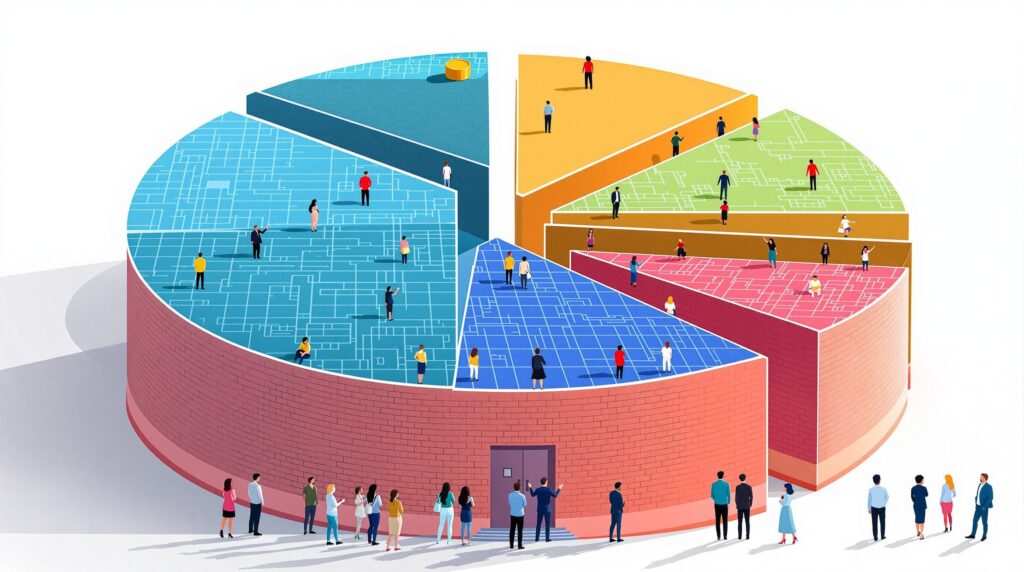[rev_slider alias=”slider-1″][/rev_slider]
Understanding Layer 1 Blockchains
Layer 1 blockchains are foundational platforms that underlie the entire cryptocurrency ecosystem. These networks manage and settle transactions while providing the crucial infrastructure needed for decentralized applications. Examples include Bitcoin and Ethereum, which facilitate peer-to-peer transactions and smart contracts.
What are Layer 1 Blockchains? Layer 1 blockchains are the fundamental infrastructures that form the base of the cryptocurrency network, handling primary functions such as transaction settlements and security.
Key Features of Layer 1 Blockchains
Layer 1 technologies are renowned for their decentralization, security, and scalability. These blockchains utilize consensus mechanisms such as Proof-of-Work (PoW) and Proof-of-Stake (PoS) to ensure transaction validity and network integrity.
- Decentralization: Layer 1 blockchains typically operate without a central authority, distributing control among numerous network participants.
- Security: The use of cryptographic protocols ensures that transactions are secure and less susceptible to malicious attacks.
- Scalability: These platforms are engineered to handle large volumes of transactions simultaneously, although scalability remains a significant challenge.
Bitcoin, often referred to as the first successful implementation of a Layer 1 blockchain, introduced the concept of a digital currency that operates independently of centralized banks. Ethereum, on the other hand, extended the utility of Layer 1 by incorporating smart contract functionality, allowing for programmable financial transactions.
Did you know? A substantial portion of cryptocurrency’s innovation stems from Layer 1 blockchains, which serve as the bedrock for dApps and a wide array of decentralized solutions.
In places like Africa, the importance of Layer 1 blockchains cannot be overstated. They provide a much-needed alternative to traditional financial systems, characterized by limited accessibility and high transaction fees. Through platforms like Jara, which utilizes a proprietary Layer 2 blockchain (Caldera based), the revolutionary potential of crypto for economic empowerment is being realized.
By enhancing financial inclusion and enabling access to digital assets, Jara is leading the charge in this digital transformation. Holding $JARA tokens not only gives investors a stake in this burgeoning market but also offers them the tools for interacting with the wide array of services within the Jara ecosystem, including tokenized real-world assets and AI-integrated financial tools.
Layer 1 blockchains continue to evolve to meet the dynamic needs of users globally. As pioneers in decentralized solutions, these technologies pave the way for a future where financial systems are more inclusive and accessible to all, especially in regions like Africa where traditional financial services fall short.
Layer 1 blockchains are the lifeline of the crypto world, providing the robustness needed for the progression and sustainability of decentralized innovations.
To fully realize their potential, ongoing efforts focus on overcoming existing challenges, such as improving scalability and enhancing security features. These advancements promise to unlock unprecedented opportunities for users worldwide, fostering a more open and colorful digital financial landscape.
The Role of Layer 2 Solutions
Layer 2 solutions are designed to enhance the capabilities of Layer 1 blockchains by addressing common issues like scalability and speed constraints. By operating as secondary protocols atop existing blockchains, these solutions offer much-needed improvements in transaction processing and fee reduction. A prime example of a Layer 2 solution is the Lightning Network, which provides faster transaction processing on Bitcoin’s blockchain.
Advancements with Layer 2 Technologies
The innovations within Layer 2 technologies are game-changers for blockchain efficiency. Technologies such as state channels and sidechains enable transactions to occur off-chain and be settled on the main blockchain later. This not only reduces congestion but also boosts overall network efficiency. Imagine traffic on a busy roadway being diverted onto side routes, allowing for a smoother flow—the same principle applies here.
How do Layer 2 solutions improve blockchain efficiency? Layer 2 solutions increase blockchain efficiency by handling transactions off-chain, thereby reducing congestion and enhancing transaction speed.
For instance, state channels create a private channel where multiple transactions can occur off-chain without each one needing to be recorded on the blockchain immediately. Upon completion, only the result of the transactions gets submitted to the main blockchain. Similarly, sidechains offer alternative pathways for transactions that can operate independently of the primary blockchain, later reconciling with the main net whenever necessary.
- State Channels: Enable transactions to happen off the blockchain, with only the final result recorded, minimizing congestion.
- Sidechains: Operate parallel to the main blockchain, allowing for more specialized and efficient transaction processing.
These advancements do more than just improve speed and processing capabilities; they also make blockchain technology more accessible for widespread applications. As the digital landscape in Africa continues to grow, the potential for layered blockchain solutions becomes increasingly significant. The demand for accessible financial services is rising, and Layer 2 solutions are a promising development for overcoming existing infrastructure challenges.
“Layer 2 solutions are not just upgrades; they’re the future of blockchain scalability, opening doors to a new era of innovation and application in the digital economy.” – Blockchain Technology Expert
In regions like Africa, where digital financial services can drive economic transformation, these solutions are pivotal. They allow for more efficient transaction processing and lower transaction fees, which can lead to increased inclusion and participation in the digital economy. This reflects the vision of Jara as it seeks to fuel the African digital asset economy through its own proprietary Layer 2 blockchain initiatives, making strides towards a more seamless and integrated financial ecosystem.
[rev_slider alias=”text-call-cta”][/rev_slider]
Comparison: Layer 1 vs Layer 2 Blockchain Solutions
When delving into the world of blockchain, it’s essential to understand the fundamental differences between Layer 1 and Layer 2 solutions. These differences significantly impact their functionality, optimization, and the ways they foster innovation in the crypto space.
Key Differences in Functionality and Optimization
Layer 1 blockchains are the foundational frameworks upon which cryptocurrencies operate. They include popular platforms such as Bitcoin and Ethereum, serving as the primary architecture supporting blockchain technology. However, the primary focus of Layer 1 solutions is not just to operate as standalone entities but to provide a robust, secure, and immutable ledger system for transactions.
What is a Layer 1 Blockchain? A Layer 1 blockchain is the base level or the main network that facilitates the establishment of the blockchain environment, enabling decentralized transactions and computing.
On the other hand, Layer 2 solutions are secondary frameworks built atop Layer 1 blockchains. These solutions aim to enhance the base layer’s performance by improving transaction speed and scalability without compromising security. One classic example is the Lightning Network on Bitcoin, which facilitates faster transactions at a lower cost.
Enhancing Speed and Scalability
Layer 1 solutions focus on providing a stable, secure environment, but challenges like scalability constraints often arise as network traffic grows. Take the Ethereum mainnet, where increasing user adoption has led to rising gas fees—a barrier for smaller transactions. Layer 2 solutions address these issues by processing transactions off-chain and then bundling them for settlement on the Layer 1 network, drastically reducing congestion on the mainnet.
Why use Layer 2 solutions? Layer 2 solutions improve transaction throughput and reduce costs by handling transactions off-chain, thus alleviating the load on the primary blockchain network.
Use Cases and Applications
The differing functionalities of Layer 1 and Layer 2 solutions lead to varied use cases across the blockchain landscape:
- Secure Ledger: Layer 1 (e.g., Bitcoin, Ethereum) acts as a secure, immutable ledger ideal for storing large-scale digital assets.
- Micro-transactions: Layer 2 solutions are perfect for environments requiring fast processing of micro-transactions, such as small payments or gaming rewards.
- Smart Contracts: While Layer 1 solutions enable smart contract execution, Layer 2 enhances efficiency by reducing latency and transaction fees.
- Decentralized Applications (dApps): Both layers support dApps, but Layer 2 facilitates more dynamic interactions while maintaining the security of the underlying Layer 1 blockchain.
Notably, cryptocurrency-related fraud defense requires a firm understanding of both layers to effectively navigate legal complexities involving these technologies.
Connecting to Jara’s Ecosystem
Jara exemplifies the synergy between Layer 1 and Layer 2 through its proprietary solutions that boost Africa’s digital asset economy. Positioned at the forefront of blockchain innovation, Jara leverages these technologies to implement projects like the Lagos airport tokenization, integrating both security and efficiency into its operations.
Jara’s unique integration of Layer 1 and Layer 2 platforms showcases how blockchain innovation can fuel infrastructure projects and economic empowerment in Africa.
The unfolding trajectory of these technologies reveals a vibrant marketplace poised for substantial growth. By understanding and utilizing the unique strengths of Layer 1 and Layer 2 solutions, stakeholders like Jara can vastly improve access to capital and elevate financial inclusion across regions like Africa. This balance between foundational stability and innovative scalability makes blockchain an exciting frontier in financial technology today.
For further insights on security issues surrounding cryptocurrencies, please visit our comprehensive overview on crypto security and fraud.
The Future of Layer 1 and Layer 2 Blockchains
The evolution of Layer 1 and Layer 2 technologies is crucial for the mass adoption of cryptocurrencies. As blockchain technology advances, these solutions will play a pivotal role in reducing costs, increasing throughput, and improving user experience globally. In Africa, where financial access remains limited, the adoption of these blockchain technologies can significantly bridge the gap, providing a robust infrastructure for digital transactions.
Emerging Trends and Challenges
Future developments will likely focus on integrating interoperability between diverse blockchain platforms, enhancing scalability further, and addressing regulatory hurdles that may impact the growth and integration of blockchain solutions in various industries.
What is interoperability in blockchain? Interoperability refers to the ability of different blockchain networks to communicate and exchange information seamlessly, ensuring a more connected and efficient blockchain ecosystem.
With Africa’s rapid digital transformation as highlighted by Jara’s initiatives, new opportunities are emerging. The $JARA token, for instance, is not only propelling financial inclusion but also demonstrating the effectiveness of integrating different layers of blockchain technology to advance economic empowerment.
Interoperability as a Key Focus
As blockchain technology continues to grow, interoperability between Layer 1 and Layer 2 solutions will become increasingly important. This integration allows for the seamless transfer of information and assets, making the blockchain network more usable and accessible. Interoperability will enable blockchain networks to support more complex decentralized applications (dApps), thereby improving user experience across different platforms.
Projects like Bitcoin and cryptocurrency crime defense are also affected by these advancements, as improved interoperability can help reduce fraudulent activities by enhancing transparency across various platforms.
“Bridging global capital to African assets” — Jara’s mission highlights the potential of blockchain technology to open new paths for investment and growth in Africa.
Scalability and User Experience Enhancements
Enhancing scalability remains a primary goal for future blockchain development. Scalability refers to a blockchain’s ability to handle a larger number of transactions as the network grows. This aspect is crucial for ensuring that blockchain platforms can support mass adoption without becoming congested or slow.
- Layer 1 Improvements: These include upgrades to the base protocol to increase its transaction capacity and reduce latency.
- Layer 2 Solutions: Utilizing off-chain processes to handle transactions more efficiently, thus relieving pressure from the main blockchain.
For the African market, scalability enhancements in Layer 1 and Layer 2 can lead to a more reliable and accessible financial system, enabling effortless transactions and interaction within the growing digital economy.
Regulatory Challenges in Blockchain Integration
One of the critical challenges that might impact the growth of blockchain technology is regulation. As blockchain platforms become more integrated into everyday financial systems, governments and financial regulators across the globe are developing frameworks to address compliance, consumer protection, and fraud prevention.
In Africa, regulatory clarity will be crucial for the successful adoption of blockchain solutions like the $JARA token. The government’s stance on digital currencies and blockchain technology can significantly influence the implementation and growth of these platforms.
- Compliance Standards: Ensuring that blockchain solutions meet international compliance standards is essential to foster trust among global investors.
- Consumer Protection: Protecting users against fraud and scams within the blockchain ecosystem requires robust frameworks and industry cooperation.
Efforts such as Jara’s strategic partnership with Standard Chartered for secure digital finance in Africa signify the importance of alignment with existing financial systems to gain regulator approval and drive blockchain adoption further.
The Jara Ecosystem showcases the power of Layer 1 and Layer 2 technologies in transforming Africa’s digital landscape, paving the way for a $200B+ market opportunity.
As we look towards the future, it is evident that Layer 1 and Layer 2 blockchains hold the key to unlocking the full potential of blockchain technology. With continued innovation and understanding across the industry, these technological frameworks can redefine how digital assets and financial services function on a global scale, especially in fast-evolving markets like Africa.
[rev_slider alias=”schedule-consultation-btn”][/rev_slider]

What is the significance of blockchain consensus mechanisms?
Blockchain consensus mechanisms, such as Proof-of-Work (PoW) and Proof-of-Stake (PoS), are critical for maintaining the security and functionality of blockchains. In a complete sentence: these mechanisms validate and confirm transactions, ensuring the integrity of the blockchain network. They play a crucial role in achieving decentralization and are fundamental to Layer 1 blockchains like Bitcoin and Ethereum.
- Proof-of-Work: Utilizes extensive computational power to secure networks.
- Proof-of-Stake: Relies on the number of tokens held to validate transactions.
How do Layer 2 solutions reduce transaction fees?
Layer 2 solutions minimize transaction fees by processing transactions off-chain, reducing congestion on the main blockchain. For example, the Lightning Network enables micro-transactions to be conducted off-chain before being settled on the Bitcoin blockchain, significantly cutting down costs. These solutions enhance scalability and efficiency, making crypto transactions more economically viable for everyday use.
What are state channels in Layer 2 blockchains?
State channels allow multiple transactions to occur off the primary blockchain, drastically improving processing speed and reducing fees. Essentially, they involve participants consenting to exchanges off-chain and only submitting the final state of those transactions to the blockchain. This method alleviates strain on the main network, fostering scalability and efficiency in Layer 2 solutions.
Can JARA’s Layer 2 blockchain be considered a Layer 1 solution?
No, JARA’s Layer 2 blockchain cannot be considered a Layer 1 solution. Layer 1 blockchains are the foundational networks that handle overall security and data integrity, like Bitcoin and Ethereum. In contrast, JARA’s Layer 2 blockchain is designed to operate atop these primary networks, enhancing their capabilities by providing higher throughput and reduced transaction fees, all while facilitating interactions within the Jara ecosystem.
Layer 1 blockchains are the base infrastructure of crypto networks, while Layer 2 solutions enhance their performance by tackling scalability and efficiency issues.

Related Practice Areas in Blockchain Technology
Explore additional pages and related practice areas that delve deeper into the fascinating world of blockchain technology.
Discover What Our Clients Are Saying
Our dedication to excellence in Layer 1 and Layer 2 blockchain solutions is evident in every case we undertake. The positive feedback from our clients is a testament to the hard work and dedication we consistently deliver.

[rev_slider alias=”slider-3″][/rev_slider]
[rev_slider alias=”slider-6″][/rev_slider]
Discover the Power of Layer 1 and Layer 2 Solutions with Jara
At Jara, we’re passionate about bridging global capital to African assets, leveraging the incredible potential of Layer 1 and Layer 2 blockchain solutions. We’ve been recognized for our dedication and expertise, but don’t just take our word for it. Explore how we’ve been acknowledged among the finest:
- Featured By: Named as one of the “Innovative Blockchain Solution Providers” for 2023 by Blockchain Innovators Association
- Recognition: Highlighted amongst the “Top Emerging Fintech Companies in Africa” for 2023 by Fintech Africa Awards
- Accolade: Listed amongst the “Best Technology Startups” in 2023 by Tech Startups Council
- Celebrated As: Part of the “Leading Innovative Companies in Blockchain” for 2023 by Global Blockchain Summit
- Honored By: Included in the “Top Blockchain Innovators” list for 2023 by Crypto Excellence Forum
“Your Voice, Our Mission” – at Jara, we champion innovation with the tenacity and dedication that has earned us global recognition.
Want to learn more about what Jara can do for you? Reach out to us at [email protected] or download our app for Android or iPhone and embark on your blockchain journey today.
Chinyere “Chi” Nnadi Bio
Founder and CEO, Jara | Layer 1 Blockchain Specialist
Content Reviewed by Chi Nnadi and his Content Team. Chi is an experienced entrepreneur dedicated to innovating the global financial landscape through blockchain technology. As Founder and CEO of Jara, he builds enterprise-grade infrastructure transforming illiquid assets into globally accessible digital tokens. With his proprietary Layer-1 blockchain expertise, Chi bridges the gap between global investors and emerging markets.
Our Content Review Process
Chi Nnadi along with Jara’s dedicated content team, pledge to offer top-notch material. Our content guidelines ensure thoroughness, reputable sources, unbiased scrutiny, among other quality metrics. Please let us know if there is anything you believe to be inaccurate.
















